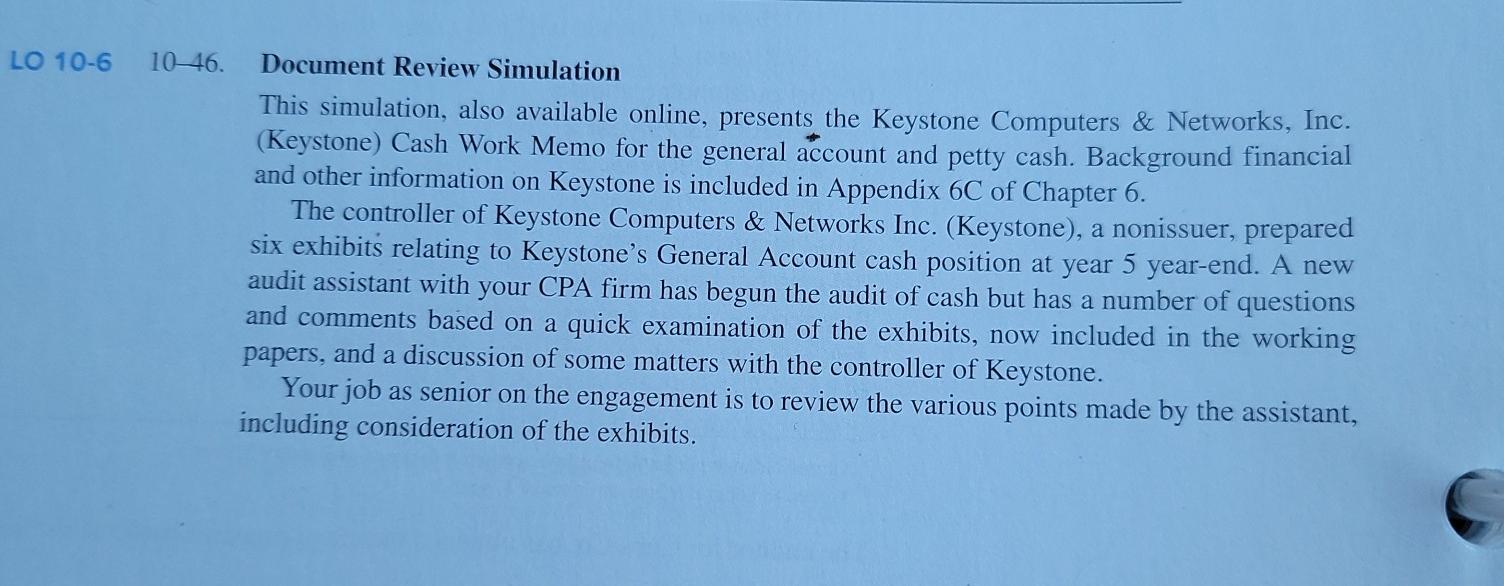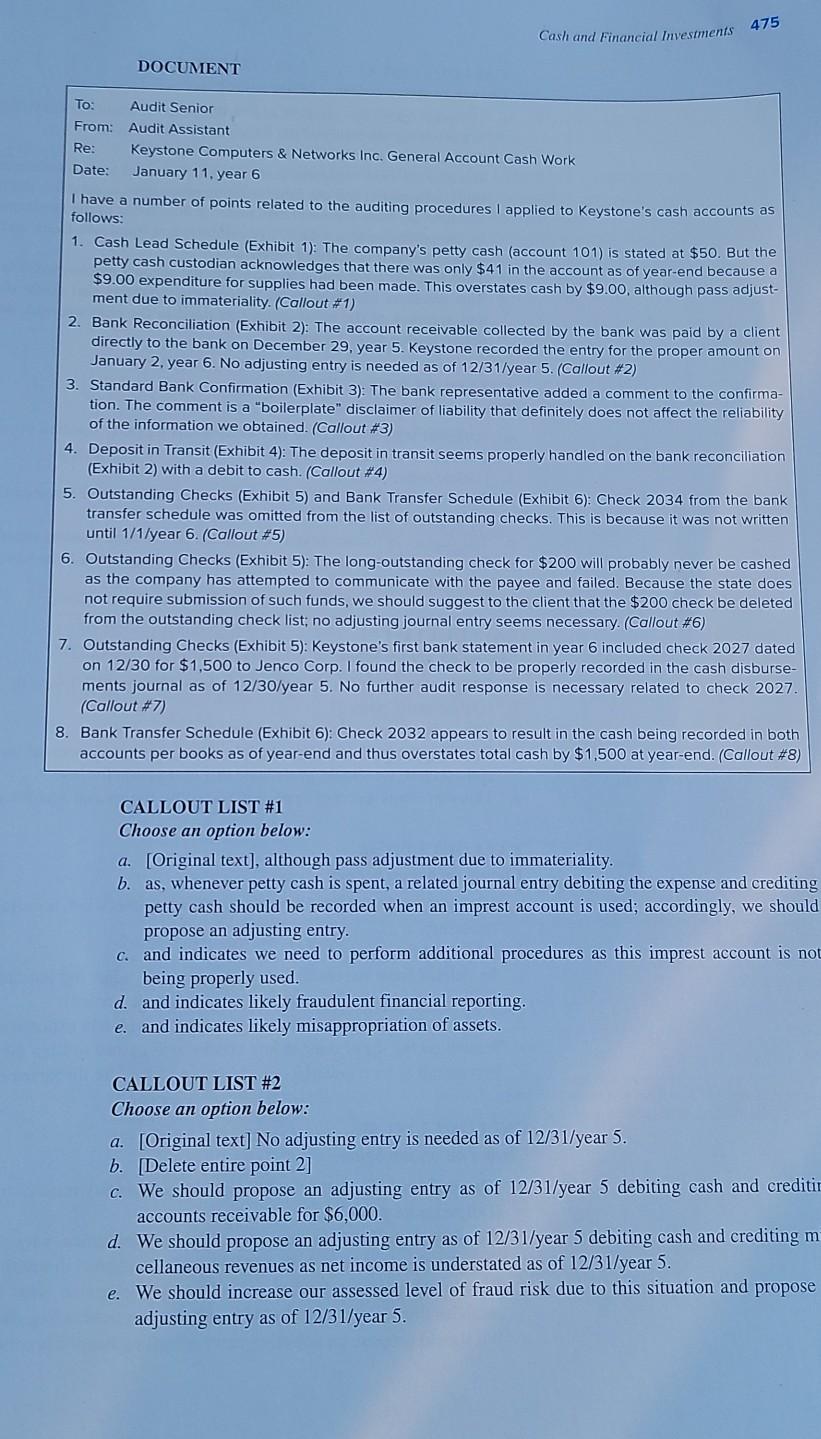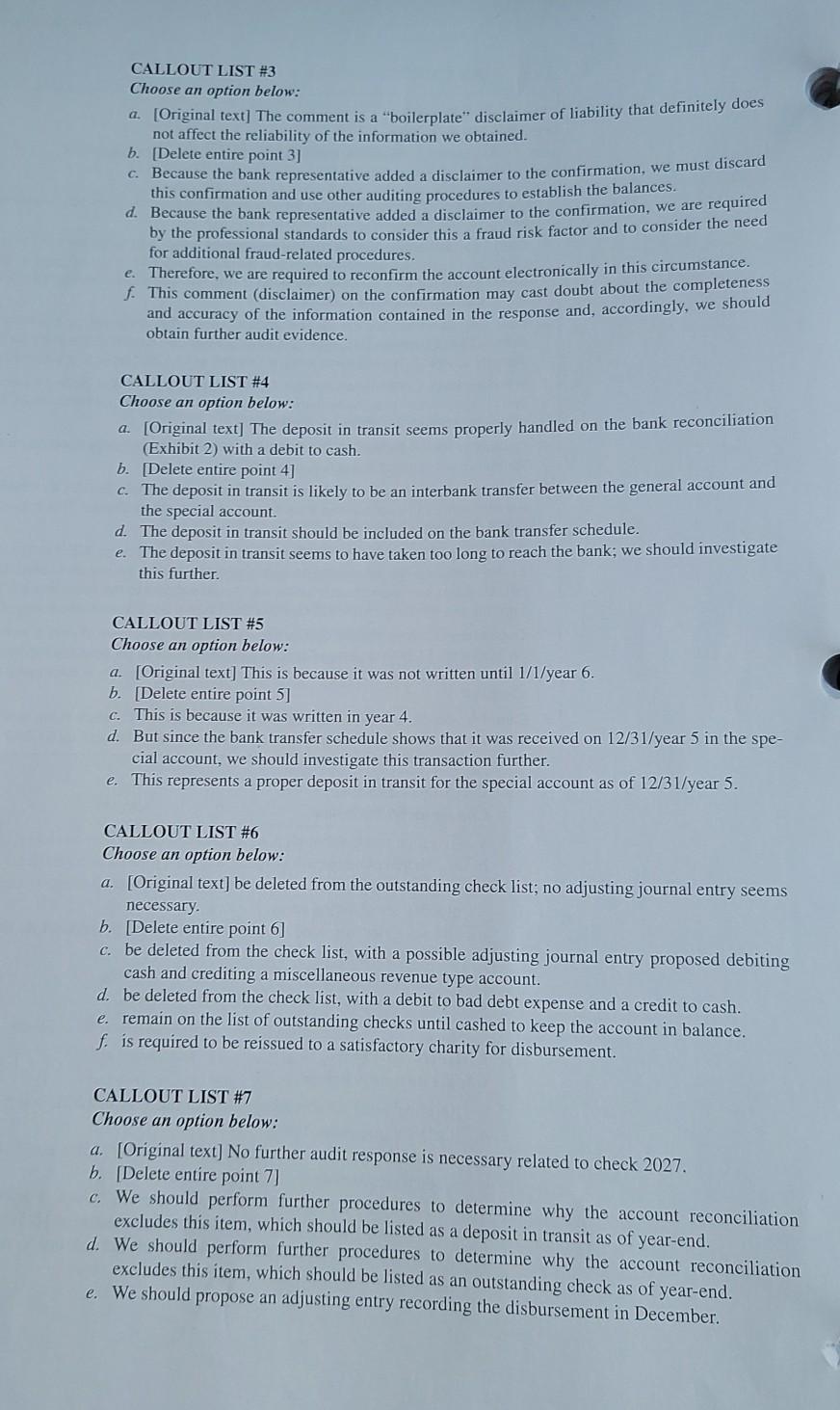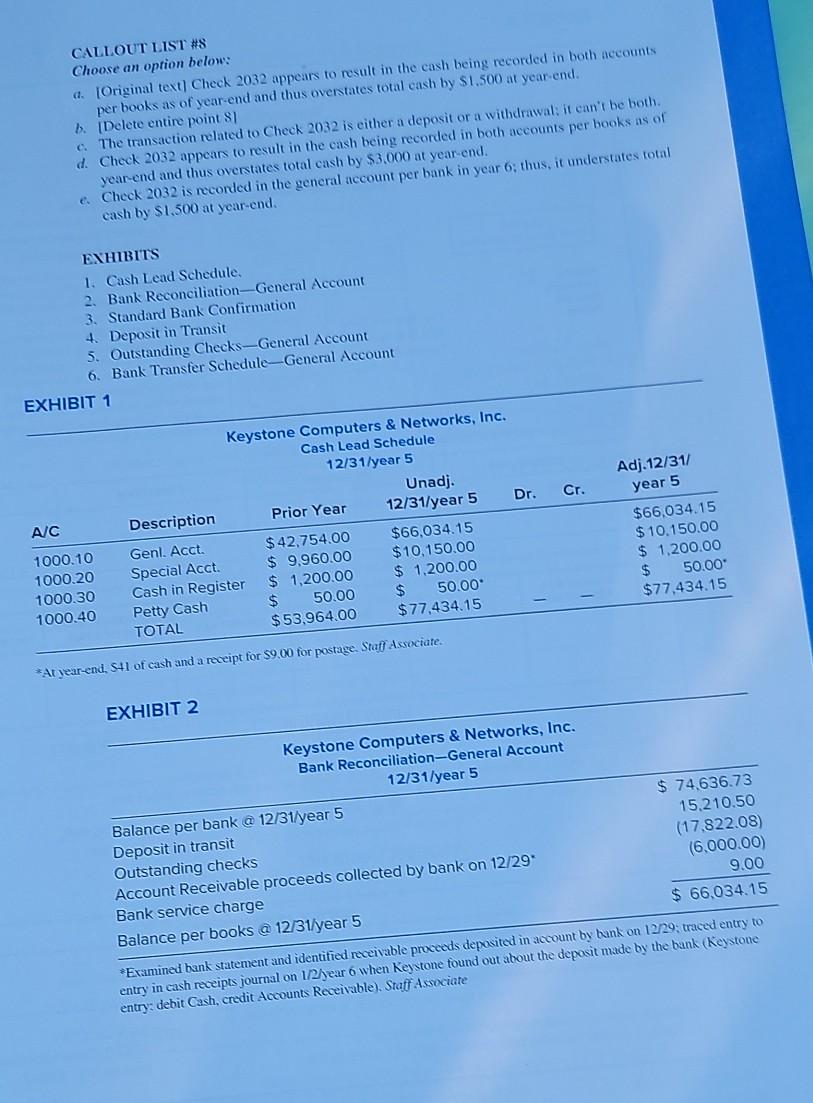Answered step by step
Verified Expert Solution
Question
1 Approved Answer
LO 10-6 10_46. Document Review Simulation This simulation, also available online, presents the Keystone Computers & Networks, Inc. (Keystone) Cash Work Memo for the general




LO 10-6 10_46. Document Review Simulation This simulation, also available online, presents the Keystone Computers & Networks, Inc. (Keystone) Cash Work Memo for the general account and petty cash. Background financial and other information on Keystone is included in Appendix 6C of Chapter 6. The controller of Keystone Computers & Networks Inc. (Keystone), a nonissuer, prepared six exhibits relating to Keystone's General Account cash position at year 5 year-end. A new audit assistant with your CPA firm has begun the audit of cash but has a number of questions and comments based on a quick examination of the exhibits, now included in the working papers, and a discussion of some matters with the controller of Keystone. Your job as senior on the engagement is to review the various points made by the assistant, including consideration of the exhibits. 475 Cash and Financial Investments DOCUMENT To: Audit Senior From: Audit Assistant Re: Keystone Computers & Networks Inc. General Account Cash Work Date: January 11. year 6 I have a number of points related to the auditing procedures I applied to Keystone's cash accounts as follows: 1. Cash Lead Schedule (Exhibit 1): The company's petty cash (account 101) is stated at $50. But the petty cash custodian acknowledges that there was only $41 in the account as of year-end because a $9.00 expenditure for supplies had been made. This overstates cash by $9.00, although pass adjust- ment due to immateriality. (Callout #1) 2. Bank Reconciliation (Exhibit 2): The account receivable collected by the bank was paid by a client directly to the bank on December 29. year 5. Keystone recorded the entry for the proper amount on January 2 year 6. No adjusting entry is needed as of 12/31/year 5. (Callout #2) 3. Standard Bank Confirmation (Exhibit 3): The bank representative added a comment to the confirma- tion. The comment is a "boilerplate" disclaimer of liability that definitely does not affect the reliability of the information we obtained. (Callout #3) 4. Deposit in Transit (Exhibit 4): The deposit in transit seems properly handled on the bank reconciliation (Exhibit 2) with a debit to cash. (Callout #4) 5. Outstanding Checks (Exhibit 5) and Bank Transfer Schedule (Exhibit 6): Check 2034 from the bank transfer schedule was omitted from the list of outstanding checks. This is because it was not written until 1/1/year 6. (Callout #5) 6. Outstanding Checks (Exhibit 5): The long-outstanding check for $200 will probably never be cashed as the company has attempted to communicate with the payee and failed. Because the state does not require submission of such funds, we should suggest to the client that the $200 check be deleted from the outstanding check list: no adjusting journal entry seems necessary. (Callout #6) 7. Outstanding Checks (Exhibit 5): Keystone's first bank statement in year 6 included check 2027 dated on 12/30 for $1,500 to Jenco Corp. I found the check to be properly recorded in the cash disburse- ments journal as of 12/30/year 5. No further audit response is necessary related to check 2027. (Callout #7) 8. Bank Transfer Schedule (Exhibit 6): Check 2032 appears to result in the cash being recorded in both accounts per books as of year-end and thus overstates total cash by $1,500 at year-end. (Callout #8) CALLOUT LIST #1 Choose an option below: a. [Original text), although pass adjustment due to immateriality. b. as, whenever petty cash is spent, a related journal entry debiting the expense and crediting petty cash should be recorded when an imprest account is used; accordingly, we should propose an adjusting entry. c. and indicates we need to perform additional procedures as this imprest account is not being properly used. d. and indicates likely fraudulent financial reporting. e. and indicates likely misappropriation of assets. CALLOUT LIST #2 Choose an option below: a. [Original text] No adjusting entry is needed as of 12/31/year 5. b. Delete entire point 2] C. We should propose an adjusting entry as of 12/31/year 5 debiting cash and creditir accounts receivable for $6,000. d. We should propose an adjusting entry as of 12/31/year 5 debiting cash and crediting m cellaneous revenues as net income is understated as of 12/31/year 5. e. We should increase our assessed level of fraud risk due to this situation and propose adjusting entry as of 12/31/year 5. CALLOUT LIST #3 Choose an option below: a. [Original text] The comment is a "boilerplate" disclaimer of liability that definitely does not affect the reliability of the information we obtained. b. [Delete entire point 3] c. Because the bank representative added a disclaimer to the confirmation, we must discard this confirmation and use other auditing procedures to establish the balances. d. Because the bank representative added a disclaimer to the confirmation, we are required by the professional standards to consider this a fraud risk factor and to consider the need for additional fraud-related procedures. e. Therefore, we are required to reconfirm the account electronically in this circumstance. f. This comment (disclaimer) on the confirmation may cast doubt about the completeness and accuracy of the information contained in the response and, accordingly, we should obtain further audit evidence. CALLOUT LIST #4 Choose an option below: a. [Original text] The deposit in transit seems properly handled on the bank reconciliation (Exhibit 2) with a debit to cash. b. [Delete entire point 4] c. The deposit in transit is likely to be an interbank transfer between the general account and the special account. d. The deposit in transit should be included on the bank transfer schedule. e. The deposit in transit seems to have taken too long to reach the bank; we should investigate this further. CALLOUT LIST #5 Choose an option below: a. [Original text] This is because it was not written until 1/1/year 6. b. [Delete entire point 5] C. This is because it was written in year 4. d. But since the bank transfer schedule shows that it was received on 12/31/year 5 in the spe- cial account, we should investigate this transaction further. e. This represents a proper deposit in transit for the special account as of 12/31/year 5. CALLOUT LIST #6 Choose an option below: a. [Original text] be deleted from the outstanding check list; no adjusting journal entry seems necessary b. [Delete entire point 6] c. be deleted from the check list, with a possible adjusting journal entry proposed debiting cash and crediting a miscellaneous revenue type account. d. be deleted from the check list, with a debit to bad debt expense and a credit to cash. e. remain on the list of outstanding checks until cashed to keep the account in balance. f. is required to be reissued to a satisfactory charity for disbursement. CALLOUT LIST #7 Choose an option below: a. [Original text] No further audit response is necessary related to check 2027. b. [Delete entire point 7] c. We should perform further procedures to determine why the account reconciliation excludes this item, which should be listed as a deposit in transit as of year-end. d. We should perform further procedures to determine why the account reconciliation excludes this item, which should be listed as an outstanding check as of year-end. e. We should propose an adjusting entry recording the disbursement in December. CALLOUT LIST #8 Choose an option below: a. Original text) Check 2032 appears to result in the cash being recorded in both accounts per books as of year-end and thus overstates total cash by $1.500 at year-end. b. [Delete entire point 81 c. The transaction related to Check 2032 is either a deposit or a withdrawal: it can't be both. d. Check 2032 appears to result in the cash being recorded in both accounts per books as of year-end and thus overstates total cash by $3.000 at year end. e. Check 2032 is recorded in the general account per bank in year 6; thus, it understates total cash by $1.500 at year-end. EXHIBITS 1. Cash Lead Schedule. 2. Bank Reconciliation General Account 3. Standard Bank Confirmation + Deposit in Transit 5. Outstanding Checks-General Account 6. Bank Transfer Schedule-General Account EXHIBIT 1 Cr. A/C Keystone Computers & Networks, Inc. Cash Lead Schedule 12/31/year 5 Unadj. Description Prior Year 12/31/year 5 Dr. Genl. Acct. $ 42,754.00 $66,034.15 Special Acct. $ 9,960.00 $10,150.00 Cash in Register $ 1,200.00 $ 1.200.00 Petty Cash $ 50.00 $ 50.00 TOTAL $53,964.00 $77,434.15 Adj. 12/31/ year 5 $66.034.15 $ 10,150.00 $ 1.200.00 $ 50.00 $77,434.15 1000.10 1000.20 1000.30 1000.40 At year-end, S41 of cash and a receipt for $9.00 for postage Staff Associate. EXHIBIT 2 Keystone Computers & Networks, Inc. Bank Reconciliation-General Account 12/31/year 5 Balance per bank @ 12/31/year 5 $ 74.636.73 Deposit in transit 15.210.50 Outstanding checks (17.822.08) Account Receivable proceeds collected by bank on 12/29* (6.000.00) Bank service charge 9.00 Balance per books @ 12/31/year 5 $ 66,034.15 *Examined bank statement and identified receivable proceeds deposited in account by bank on 12/29, traced entry to entry in cash receipts journal on 1/2 year 6 when Keystone found out about the deposit made by the bank (Keystone entry: debit Cash, credit Accounts Receivable). Sraff Associate LO 10-6 10_46. Document Review Simulation This simulation, also available online, presents the Keystone Computers & Networks, Inc. (Keystone) Cash Work Memo for the general account and petty cash. Background financial and other information on Keystone is included in Appendix 6C of Chapter 6. The controller of Keystone Computers & Networks Inc. (Keystone), a nonissuer, prepared six exhibits relating to Keystone's General Account cash position at year 5 year-end. A new audit assistant with your CPA firm has begun the audit of cash but has a number of questions and comments based on a quick examination of the exhibits, now included in the working papers, and a discussion of some matters with the controller of Keystone. Your job as senior on the engagement is to review the various points made by the assistant, including consideration of the exhibits. 475 Cash and Financial Investments DOCUMENT To: Audit Senior From: Audit Assistant Re: Keystone Computers & Networks Inc. General Account Cash Work Date: January 11. year 6 I have a number of points related to the auditing procedures I applied to Keystone's cash accounts as follows: 1. Cash Lead Schedule (Exhibit 1): The company's petty cash (account 101) is stated at $50. But the petty cash custodian acknowledges that there was only $41 in the account as of year-end because a $9.00 expenditure for supplies had been made. This overstates cash by $9.00, although pass adjust- ment due to immateriality. (Callout #1) 2. Bank Reconciliation (Exhibit 2): The account receivable collected by the bank was paid by a client directly to the bank on December 29. year 5. Keystone recorded the entry for the proper amount on January 2 year 6. No adjusting entry is needed as of 12/31/year 5. (Callout #2) 3. Standard Bank Confirmation (Exhibit 3): The bank representative added a comment to the confirma- tion. The comment is a "boilerplate" disclaimer of liability that definitely does not affect the reliability of the information we obtained. (Callout #3) 4. Deposit in Transit (Exhibit 4): The deposit in transit seems properly handled on the bank reconciliation (Exhibit 2) with a debit to cash. (Callout #4) 5. Outstanding Checks (Exhibit 5) and Bank Transfer Schedule (Exhibit 6): Check 2034 from the bank transfer schedule was omitted from the list of outstanding checks. This is because it was not written until 1/1/year 6. (Callout #5) 6. Outstanding Checks (Exhibit 5): The long-outstanding check for $200 will probably never be cashed as the company has attempted to communicate with the payee and failed. Because the state does not require submission of such funds, we should suggest to the client that the $200 check be deleted from the outstanding check list: no adjusting journal entry seems necessary. (Callout #6) 7. Outstanding Checks (Exhibit 5): Keystone's first bank statement in year 6 included check 2027 dated on 12/30 for $1,500 to Jenco Corp. I found the check to be properly recorded in the cash disburse- ments journal as of 12/30/year 5. No further audit response is necessary related to check 2027. (Callout #7) 8. Bank Transfer Schedule (Exhibit 6): Check 2032 appears to result in the cash being recorded in both accounts per books as of year-end and thus overstates total cash by $1,500 at year-end. (Callout #8) CALLOUT LIST #1 Choose an option below: a. [Original text), although pass adjustment due to immateriality. b. as, whenever petty cash is spent, a related journal entry debiting the expense and crediting petty cash should be recorded when an imprest account is used; accordingly, we should propose an adjusting entry. c. and indicates we need to perform additional procedures as this imprest account is not being properly used. d. and indicates likely fraudulent financial reporting. e. and indicates likely misappropriation of assets. CALLOUT LIST #2 Choose an option below: a. [Original text] No adjusting entry is needed as of 12/31/year 5. b. Delete entire point 2] C. We should propose an adjusting entry as of 12/31/year 5 debiting cash and creditir accounts receivable for $6,000. d. We should propose an adjusting entry as of 12/31/year 5 debiting cash and crediting m cellaneous revenues as net income is understated as of 12/31/year 5. e. We should increase our assessed level of fraud risk due to this situation and propose adjusting entry as of 12/31/year 5. CALLOUT LIST #3 Choose an option below: a. [Original text] The comment is a "boilerplate" disclaimer of liability that definitely does not affect the reliability of the information we obtained. b. [Delete entire point 3] c. Because the bank representative added a disclaimer to the confirmation, we must discard this confirmation and use other auditing procedures to establish the balances. d. Because the bank representative added a disclaimer to the confirmation, we are required by the professional standards to consider this a fraud risk factor and to consider the need for additional fraud-related procedures. e. Therefore, we are required to reconfirm the account electronically in this circumstance. f. This comment (disclaimer) on the confirmation may cast doubt about the completeness and accuracy of the information contained in the response and, accordingly, we should obtain further audit evidence. CALLOUT LIST #4 Choose an option below: a. [Original text] The deposit in transit seems properly handled on the bank reconciliation (Exhibit 2) with a debit to cash. b. [Delete entire point 4] c. The deposit in transit is likely to be an interbank transfer between the general account and the special account. d. The deposit in transit should be included on the bank transfer schedule. e. The deposit in transit seems to have taken too long to reach the bank; we should investigate this further. CALLOUT LIST #5 Choose an option below: a. [Original text] This is because it was not written until 1/1/year 6. b. [Delete entire point 5] C. This is because it was written in year 4. d. But since the bank transfer schedule shows that it was received on 12/31/year 5 in the spe- cial account, we should investigate this transaction further. e. This represents a proper deposit in transit for the special account as of 12/31/year 5. CALLOUT LIST #6 Choose an option below: a. [Original text] be deleted from the outstanding check list; no adjusting journal entry seems necessary b. [Delete entire point 6] c. be deleted from the check list, with a possible adjusting journal entry proposed debiting cash and crediting a miscellaneous revenue type account. d. be deleted from the check list, with a debit to bad debt expense and a credit to cash. e. remain on the list of outstanding checks until cashed to keep the account in balance. f. is required to be reissued to a satisfactory charity for disbursement. CALLOUT LIST #7 Choose an option below: a. [Original text] No further audit response is necessary related to check 2027. b. [Delete entire point 7] c. We should perform further procedures to determine why the account reconciliation excludes this item, which should be listed as a deposit in transit as of year-end. d. We should perform further procedures to determine why the account reconciliation excludes this item, which should be listed as an outstanding check as of year-end. e. We should propose an adjusting entry recording the disbursement in December. CALLOUT LIST #8 Choose an option below: a. Original text) Check 2032 appears to result in the cash being recorded in both accounts per books as of year-end and thus overstates total cash by $1.500 at year-end. b. [Delete entire point 81 c. The transaction related to Check 2032 is either a deposit or a withdrawal: it can't be both. d. Check 2032 appears to result in the cash being recorded in both accounts per books as of year-end and thus overstates total cash by $3.000 at year end. e. Check 2032 is recorded in the general account per bank in year 6; thus, it understates total cash by $1.500 at year-end. EXHIBITS 1. Cash Lead Schedule. 2. Bank Reconciliation General Account 3. Standard Bank Confirmation + Deposit in Transit 5. Outstanding Checks-General Account 6. Bank Transfer Schedule-General Account EXHIBIT 1 Cr. A/C Keystone Computers & Networks, Inc. Cash Lead Schedule 12/31/year 5 Unadj. Description Prior Year 12/31/year 5 Dr. Genl. Acct. $ 42,754.00 $66,034.15 Special Acct. $ 9,960.00 $10,150.00 Cash in Register $ 1,200.00 $ 1.200.00 Petty Cash $ 50.00 $ 50.00 TOTAL $53,964.00 $77,434.15 Adj. 12/31/ year 5 $66.034.15 $ 10,150.00 $ 1.200.00 $ 50.00 $77,434.15 1000.10 1000.20 1000.30 1000.40 At year-end, S41 of cash and a receipt for $9.00 for postage Staff Associate. EXHIBIT 2 Keystone Computers & Networks, Inc. Bank Reconciliation-General Account 12/31/year 5 Balance per bank @ 12/31/year 5 $ 74.636.73 Deposit in transit 15.210.50 Outstanding checks (17.822.08) Account Receivable proceeds collected by bank on 12/29* (6.000.00) Bank service charge 9.00 Balance per books @ 12/31/year 5 $ 66,034.15 *Examined bank statement and identified receivable proceeds deposited in account by bank on 12/29, traced entry to entry in cash receipts journal on 1/2 year 6 when Keystone found out about the deposit made by the bank (Keystone entry: debit Cash, credit Accounts Receivable). Sraff Associate
Step by Step Solution
There are 3 Steps involved in it
Step: 1

Get Instant Access to Expert-Tailored Solutions
See step-by-step solutions with expert insights and AI powered tools for academic success
Step: 2

Step: 3

Ace Your Homework with AI
Get the answers you need in no time with our AI-driven, step-by-step assistance
Get Started


